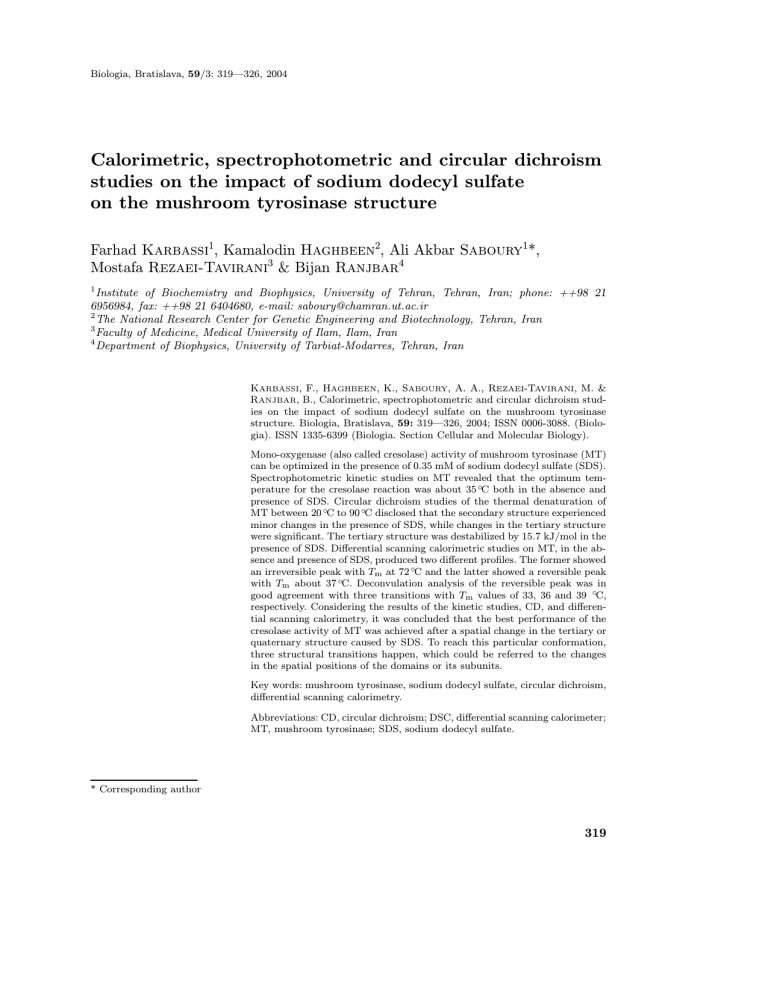Calorimetric, spectrophotometric and circular dichroism studies on
advertisement

Biologia, Bratislava, 59/3: 319—326, 2004 Calorimetric, spectrophotometric and circular dichroism studies on the impact of sodium dodecyl sulfate on the mushroom tyrosinase structure Farhad Karbassi1, Kamalodin Haghbeen2, Ali Akbar Saboury1*, Mostafa Rezaei-Tavirani3 & Bijan Ranjbar4 1 Institute of Biochemistry and Biophysics, University of Tehran, Tehran, Iran; phone: ++98 21 6956984, fax: ++98 21 6404680, e-mail: saboury@chamran.ut.ac.ir 2 The National Research Center for Genetic Engineering and Biotechnology, Tehran, Iran 3 Faculty of Medicine, Medical University of Ilam, Ilam, Iran 4 Department of Biophysics, University of Tarbiat-Modarres, Tehran, Iran KARBASSI, F., HAGHBEEN, K., SABOURY, A. A., REZAEI-TAVIRANI, M. & RANJBAR, B., Calorimetric, spectrophotometric and circular dichroism studies on the impact of sodium dodecyl sulfate on the mushroom tyrosinase structure. Biologia, Bratislava, 59: 319—326, 2004; ISSN 0006-3088. (Biologia). ISSN 1335-6399 (Biologia. Section Cellular and Molecular Biology). Mono-oxygenase (also called cresolase) activity of mushroom tyrosinase (MT) can be optimized in the presence of 0.35 mM of sodium dodecyl sulfate (SDS). Spectrophotometric kinetic studies on MT revealed that the optimum temperature for the cresolase reaction was about 35 ◦C both in the absence and presence of SDS. Circular dichroism studies of the thermal denaturation of MT between 20 ◦C to 90 ◦C disclosed that the secondary structure experienced minor changes in the presence of SDS, while changes in the tertiary structure were significant. The tertiary structure was destabilized by 15.7 kJ/mol in the presence of SDS. Differential scanning calorimetric studies on MT, in the absence and presence of SDS, produced two different profiles. The former showed an irreversible peak with Tm at 72 ◦C and the latter showed a reversible peak with Tm about 37 ◦C. Deconvulation analysis of the reversible peak was in good agreement with three transitions with Tm values of 33, 36 and 39 ◦C, respectively. Considering the results of the kinetic studies, CD, and differential scanning calorimetry, it was concluded that the best performance of the cresolase activity of MT was achieved after a spatial change in the tertiary or quaternary structure caused by SDS. To reach this particular conformation, three structural transitions happen, which could be referred to the changes in the spatial positions of the domains or its subunits. Key words: mushroom tyrosinase, sodium dodecyl sulfate, circular dichroism, differential scanning calorimetry. Abbreviations: CD, circular dichroism; DSC, differential scanning calorimeter; MT, mushroom tyrosinase; SDS, sodium dodecyl sulfate. * Corresponding author 319 Introduction Despite the ubiquitous occurrence and vital role in melanogensis of tyrosinase [EC 1.14.18.1], neither its structure nor the mechanisms of its reactions are well understood (HEARING & TSUKAMOTO, 1991). This enzyme catalyzes the ortho-hydroxylation of monophenols (known as cresolase activity) and the oxidation of the produced o-diphenols (known as catecholase activity) to o-quinones. Because of instability, o-quinones polymerize nonenzymatically to brown, black or red pigments (PROTA, 1988; MARTINEZ & WHITAKER, 1995; KERMASHA et al., 2001). Tyrosinase is also responsible for the enzymatic browning of fruits and mushrooms, which results in economical losses to the farmers (SHAHIDI & NACZK, 1995). Although the mechanisms of tyrosinase reactions, or even its structure are not clearly understood, demands for its applications or, at least, controlling its activities are high enough to prompt more systematic and sophisticated research. In-vitro studies have already shown that some reagents, like sodium dodecyl sulfate (SDS), are able to modify the activities of tyrosinases from different sources (WITTENBERG & TRIPLETT, 1985; MOORE & FLURKEY, 1990; JIMENEZ & GARCIA-CARMONA, 1996; NELLAIAPPAN & SUGUMARAN, 1996; CHAZZARA et al., 1997; ESCRIBANO et al., 1997; ESPIN & WICHERS, 1999a). The activation of tyrosinases caused by different treatment or other detergents (MOORE & FLURKEY, 1990; NELLAIAPPAN & SUGUMARAN, 1996; ESPIN & WICHERS, 1999a,b), acid shock (KENETTEN, 1957), fatty acids (SUGUMARAN & NELLAIAPPAN, 1991), alcohols (ASADA et al., 1993; ESPIN & WICHERS, 1999b), proteases (KING & FLURKEY, 1987; ROBINSON & DRY, 1992; CHOSA et al., 1997; ESPIN et al., 1999) and pathogen attack (SOLER-RIVAS et al., 1997) has also been reported. To obtain more insight into the mechanism of SDS interaction with tyrosinase and also a deeper understanding about the structure of this enzyme, concerted experiments were designed to study thermal behavior and simultaneous structural changes of mushroom (Agaricus bisporus) tyrosinase (MT) in the absence and presence of SDS. Results of these experiments are presented and discussed in this paper. Material and methods MT (Agaricus bisporus) and SDS were purchased from SigmaTM Chemical and Biochemical Company. 4-[(4Methylphenyl)azo]-phenol (MePAPh) was synthesized 320 as explained earlier (HAGHBEEN & TAN, 1998). All other materials and reagents were of analytical grade. The reported results in this paper are the outcome of triplicate measurements. Substrates and enzyme, as well as the enzymatic reaction’s conditions, were identical to the recently published procedures (HAGHBEEN & TAN, 2003). Therefore, all the enzymatic reactions were carried out in phosphate buffer (0.01 M) at pH 6.8 and 20 ◦C unless a different temperature was needed. Rates of the reactions were measured spectrophotometrically from the decrease in the optical density at the λmax of the substrate using a Shimadzu spectrophotometer, UV-3100 model. Hence, cresolase reactions of MT in the presence of MePAPh were monitored at 352 nm. Activity measurements were carried out in the presence of a constant concentration of substrates (5 × 10−5 M) and a constant concentration of MT, 0.17 mg/mL, in a quartz cell containing 1500 µL of the reaction mixture. The cresolase reactions of MT in the presence of SDS were carried out under the aforementioned circumstances except for the detergent concentration. Therefore, these reactions were run at various concentrations (0, 0.1, 0.25, 0.35, 0.5, 0.75 and 1 mM) of SDS in 1500 µL of reaction mixture containing constant concentrations of MT and substrate, as mentioned above, at pH 6.8 and 20 ◦C. Circular dichroism (CD) experiments were performed using a Jasco J-715 spectrophotometer. The results were expressed as ellipticity [θ] (deg cm2 dmol−1 ) considering a mean amino acid residues weight (MRW) of 125. The spectrophotometer was equipped with a temperature programmer for controlling the rate of temperature changes. The scan rate was 2 K min−1 in melting experiments. The data were smoothed by applying the Jasco J-715 software including a fast Fourier-transform noise reduction routine. This allows the enhancement of the most of noisy spectra without distorting the shapes of their peaks. Far-UV studies were performed in the presence of MT (0.17 mg/mL) and SDS (0.35 mM), while nearUV experiments were performed with 1.87 mg/mL MT and 4 mM SDS. Due to the low extinction coefficient of the protein at the wavelength applied in the near-UV experiment, higher concentrations of MT and consequently SDS had to be used. However, the ratio of the molar concentrations was kept approximately identical (∼263) in all CD and calorimetry experiments. Differential scanning calorimeter (DSC) experiments were carried out on a Scal 1 microcalorimeter (Russian); the scan rate was 2 K min−1 . An additional pressure of 1.5 atm was applied during all DSC runs, in order to prevent any possible degassing of the solutions during heating. A concentration of 1 mg/mL of MT was applied in these experiments. Thus, the concentration of SDS was fixed at 2 mM to provide the same molar ratio used in CD experiments. The dos-based software package (Scal-2 supplied by Scal, Russia) was used for the data analysis. The deconvolution analysis a Relative Activity 5HODWLYH$FWLYLW\ Fig. 1. Relative cresolase activity of tyrosinase versus SDS concentration in phosphate buffer 10 mM, pH 6.8. To find a conceptual correlation between the structure and the activity of MT, it was planed to study the activity of MT over a wide range of temperature. Experiments were done both in the presence and in the absence of SDS. Figure 1 illustrates the results of these studies. Previous works had already shown that this anionic detergent was able to modify the activities of MT considerably (WITTENBERG & TRIPLETT, 1985; MOORE & FLURKEY, 1990; JIMENEZ & GARCIACARMONA, 1996; NELLAIAPPAN & SUGUMARAN, 1996; CHAZZARA et al., 1997; ESCRIBANO et al., 1997; ESPIN & WICHERS, 1999a). Experiments in this lab confirmed that SDS (0.35 mM) optimized the mono-oxygenase activity of MT. The result was in good agreement with the previous reports. Activity study of MT, over a wide range of temperature (Fig. 2), shows that MT reaches its highest mono-oxygenase activity at 35 ◦C even in the presence of SDS. Apparently, SDS improves the rate of the enzymatic reaction of MT but it does not change the optimum temperature for the reaction. To verify this phenomenon and to obtain a better understanding about the impacts of SDS, CD and DSC studies were carried out. The thermal denaturation curves for tyrosinase are shown in Figures 3–5. Results of the thermal denaturation of α-helix (helices) in the absence and presence of SDS have been illustrated in Figure 3. In this case denaturation was followed by measuring the ellipticity changes at 222 nm. As b Relative Activity Results and discussion Temperature ( C) >6'6@P0 and fitting were accomplished according to the theory by PRIVALOV & POTEKHIN (1986). o o Temperature ( C) Fig. 2. Relative cresolase activity of tyrosinase versus temperature changes in phosphate buffer 10 mM, pH 6.8. In the absence (a) and in the presence (b) of SDS (0.35 mM). a result, the denaturation temperature (Tm ) of the enzyme was about 54 and 63 ± 0.5 ◦C in the absence and presence of SDS, respectively. Figure 4 shows the denaturation curves of β-sheets in the absence and presence of SDS. Denaturation was monitored by measuring the ellipticity at 217 nm, which resulted in Tm values of 62 and 60 ± 0.5 ◦C for the enzyme in the absence and presence of SDS, respectively. Similarly, changes in the tertiary structure of MT in the absence and presence of SDS during the thermal denaturation were studied by recording the ellipticity changes at 258 nm. The obtained data (Fig. 5) produced the Tm values of 72 and 64 ± 0.5 ◦C for the former and latter situations, respectively. Assuming a two-state mechanism for the thermal denaturation of MT, the Gibbs free energy of protein unfolding, ∆G◦ , was calculated using the following equations (PACE, 1986, 1990; 321 Table. 1. ∆G◦ (25 ◦C) and Tm for the various structures of two samples of MT. Tyrosinase sample Structure Without SDS α-helix β-sheet tertiary α-helix β-sheet tertiary With SDS 7.9 9.8 29.0 9.1 9.2 13.3 7 θ 7 R Fig. 3. The change of ellipticity of tyrosinase at 222 nm due to increase of temperature (for following α-helices denaturation) in phosphate buffer 10 mM, pH 6.8. In the absence (a) and in the presence (b) of SDS (0.35 mM). SABOURY & MOOSAVI-MOVAHEDI, 1995): YN − Yobs YN − YD (2) Fd YN − Yobs = 1 − Fd Yobs − YD (3) Fd = K= & E 7 R & Fig. 4. The change of ellipticity of tyrosinase at 217 nm due to increase of temperature (for following β-sheets denaturation) in phosphate buffer 10 mM, pH 6.8. In the absence (a) and in the presence (b) of SDS (0.35 mM). YN − Yobs (4) Yobs − YD R and T represent the universal gas constant and the absolute temperature, respectively. Yobs is the observed ellipticity used to follow unfolding during transition. YN and YD are the values of ellipticity for the native and denatured states of protein, respectively. Based on the extracted data from Fig∆G◦ = −RT ln K = −RT ln (1) & Native(N) ⇔ Denatured(D) R 7 E & GHJ FP GP O R GHJ FP GP O θ 322 D θ θ 54 62 72 63 60 65 GHJ FP GP O ∆G◦ (25 ◦C)/kJmol−1 D GHJ FP GP O Tm ( ◦C) 5 4 3 G (kJ/mol) GP O GHJ FP b 1 0 a 55 65 75 -2 -3 7 T ( oC) o & Fig. 5. The change of ellipticity of tyrosinase at 258 nm due to increase of temperature (for following tertiary structure denaturation) in phosphate buffer 10 mM, pH 6.8. In the absence (a) and in the presence (b) of SDS (0.35 mM). 3 2 4 3 G (kJ/mol) G (kJ/mol) 2 -1 45 a b 2 1 0 -1 45 55 65 75 -2 a -3 1 0 T ( oC) -1 45 55 65 75 Fig. 7. The free energy of unfolding (calculated from equation (4) by assuming a two state mechanism) versus temperature based on the data of Figure 4. -2 -3 -4 -5 T ( oC) 4 b G (kJ/mol) 3 2 1 0 -1 45 55 65 75 -2 T ( oC) Fig. 6. The free energy of unfolding (calculated from equation (4) by assuming a two state mechanism) versus temperature based on the data of Figure 3. ures 3–5 and using the equation (4), the Gibbs free energies of unfolding (∆G◦ ) were obtained and plotted in Figures 6-8, respectively. ∆G◦ (25 ◦C) as a criterion of the thermal stability of MT, for both situations, was obtained from the energy functions of the above-illustrated plots at 25 ◦C. These results are collected in Table 1 indicating that the presence of SDS stabilizes α-helix (helices) by 1.2 kJ/mol and destabilizes β-sheets and the tertiary structure of MT by 0.6 kJ/mol and 15.7 kJ/mol, respectively. This means that SDS does not produce notable changes in the stability of the secondary structure of MT but it decreases the thermal stability of the tertiary structure significantly. To evaluate the aforementioned results, thermal denaturation of MT both in the absence and presence of SDS was also studied by differential scanning calorimeter (DSC). Figure 9 depicts the DSC profiles of both situations. Denaturation of MT in the absence of SDS was irreversible with a Tm about 72 ◦C (Fig. 9a). This temperature falls right on the Tm value of the tertiary structure de- 323 12 a 10 G (kJ/mol) 8 6 4 2 0 -2 55 60 65 70 75 80 -4 T ( oC) 3 G (kJ/mol) 2 b 1 0 -1 55 60 65 70 75 80 -2 -3 -4 -5 T ( oC) Fig. 8. The free energy of unfolding (calculated from equation (4) by assuming a two state mechanism) versus temperature based on the data of Figure 5. Table. 2. Enthalpy of partial unfolding and Tm for the subpeaks of MT in the presence of 2 mM solution of SDS. Subpeaks Tm ( ◦C ) ∆H/(kJ mol−1 ) I II III 33 36 39 530 ± 5 744 ± 7 763 ± 8 naturation obtained from CD studies. There was another transition at higher temperatures, which was left unstudied because of technical limitations. DSC profile of MT in the presence of SDS produced a reversible transition peak with Tm value at 37 ◦C. However, there was still a weak transition peak with Tm value about 69 ◦C. The excess molar heat capacity of the first reversible transition (Fig. 9b) was deconvolised. It was adjusted with 324 Fig. 9. The DSC profile of tyrosinase in the absence (a) and in the presence (b) of SDS (2 mM) in phosphate buffer 10 mM, pH 6.8. (c) The result of deconvulution analysis. three sub-transitions. The first two sub-transitions had almost identical magnitude and the third one was quite smaller (Fig. 9c). The Tm values and the partial unfolding enthalpies of each sub-peak are summarized in Table 2. It is concluded that major changes in the secondary structure of MT in the presence of SDS were ruled out by CD experiments. They strongly indicated considerable destabilization of the tertiary structure by SDS. The highest rate of cresolase was achieved about 35 ◦C both in the presence and absence of SDS. DSC of MT in the presence of SDS produced a reversible peak with Tm value of 37 ◦C. These facts suggest that MT exerts its highest cresolase performance through a special tertiary or quaternary structure. To reach this special conformation, three structural transitions happen, which could be referred to the changes in the spatial positions of the domains or its subunits. Acknowledgements The financial assistance from the Research Council of the University of Tehran is gratefully acknowledged for the support of this project. References ASADA, N., FUKUMITSO, T., FUJIMOTO, T. K. & MASADA, K.1993. Activation of prophenoloxidase with 2-propanol and other organic compounds in Drosophila melanogaster. Insect Biochem. Mol. Biol. 23: 515–520. CHAZZARA, S., CABANES, J., ESCARBIANO, J. & GARCIA-CARMONA, F. 1997. Kinetic study of the suicide inactivation of latent polyphenoloxidase from iceberg lettuce (Lactuca stavia) induced by 4tert-butylcatechol. Biochim. Biophys. Acta 1339: 297–303. CHOSA, N., FUKUMITSU, T., FUJIMOTO, K. & OHNISHI, E. 1997. Activation of prophenoloxidase A(1) by an activating enzyme in Drosophila melanogaster. Insect Biochem. Mol. Biol. 27: 61–68. ESPIN, J. C. & WICHERS, H. J. 1999a. Activation of a latent mushroom (Agaricus bisporus) tyrosinase isoform by sodium dodecyl sulfate (SDS). Kinetic properties of the SDS-activated isoform. J. Agric. Food Chem. 47: 3518–3525. ESPIN, J. C. & WICHERS, H. J. 1999b. Kinetics of activation of latent mushroom (Agaricus bisporus) tyrosinase by benzyl alcohol. J. Agric. Food Chem. 47: 3503–3508. ESPIN, J. C., VAN LEEUWEN, J. & WICHERS, H. J. 1999. Kinetic study of the activation process of a latent mushroom (Agaricus bisporus) tyrosinase by serine proteases. J. Agric. Food Chem. 47: 3509– 35017. ESCRIBANO, J., CABANES, J. & GARCIA-CARMONA, F. 1997. Characterisation of latent polyphenoloxidase in table beet: effect of sodium dodecyl sulphate. J. Sci. Food Agric. 73: 34–38. HAGHBEEN, K. & TAN, E. W. 1998. Facile synthesis of catechol azo dyes. J. Org. Chem. 63: 4503–4505. HAGHBEEN, K. & TAN, E. W. 2003. Direct spectrophotometric assay of mono-oxygenase and oxidase of mushroom tyrosinase in the presence of synthetic and natural substrates. J. Anal. Biochem. 312: 23– 32. HEARING, V. J. & TSUKAMOTO, K. 1991. Enzymatic control of pigmentation in mammals. FASEB J. 5: 2902–2909. JIMENEZ, M. & GARCIA-CARMONA, F. 1996. The effect of sodium dodecyl sulphate on polyphenoloxidase. Phytochemistry 42: 1503–1509. KENETTEN, R. H. 1957. Latent phenolase in extracts of broad-bean (Vicia faba) leaves. 1. Activation by acid and alkali. Biochem. J. 67: 300–307. KERMASHA, S., BAO, H. & BISAKOWSKY, B. 2001. Biocatalysis of tyrosinase using catechin as substrate in selected organic solvent media. J. Mol. Catal. B: Enz. 11: 929–938. KING, R. S. & FLURKEY, W. H. 1987. Effect of limited proteolysis on broad bean polyphenoloxidase. J. Sci. Food Agric. 41: 231–240. MARTINEZ, M. V. & WHITAKER, J. R. 1995. The biochemistry and cotrol of enzymatic browning. Trends Food Sci. Technol. 6: 195–200. MOORE, B. M. & FLURKEY, W. H. 1990. Sodium dodecyl sulfate activation of a plant polyphenoloxidase. J. Biol. Chem. 265: 4982–4988. NELLAIAPPAN, K. & SUGUMARAN, M. 1996. On the presence of prophenoloxidase in the hemolymph of the horseshoe crab, limulus. Comp. Biochem. Physiol. 113B: 163–168. PACE, C. N. 1990. Measuring and increasing protein stability. Trends Biotechnol. 8: 93–98. PACE, C. N. 1986. Determination and analysis of urea and guanidine hydrochloride denaturation curves. Methods Enzymol. 131: 266–280. PRIVALOV, P. L. & POTEKHIN, S. A. 1986. Scanning microcalorimetry in studying temperature-induced changes in proteins. Methods Enzymol. 131: 4–51. PROTA, G. 1988. Progress in the chemistry of melanin and related metabolism. Med. Res. Rev. 8: 525– 556. ROBINSON, S. P. & DRY, I. B. 1992. Broad bean leaf polyphenoloxidase is a 60-kilodalton protein susceptible to proteolytic cleavage. Plant Physiol. 99: 317–323. SABOURY, A. A. & MOOSAVI-MOVAHEDI, A. A. 1995. Derivation of the thermodynamic parameters involved in the elucidation of protein thermal profiles. Biochem. Educ. 23: 164–167. SABOURY, A. A., UMAR DAHOT, M., GHOBADI, S., CHAMANI, J. & MOOSAVI-MOVAHEDI, A. A. 1998. Thermodynamic studies on the interaction of cobalt with α-amylase. J. Chin. Chem.45: 667– 671. SANCHEZ-FERRER, A., RODRIGUEZ-LOPEZ, J. N. & GARCIA-CARMONA, F. 1995. Tyrosinase: a comrehensive review of its mechanism. Biochim. Biophys. Acta 1247: 1–11. SHAHIDI, F. & NACZK, M. 1995. Food Phenolics Sources: Chemistry, Effects and Application, Technomic Publishing Company, Lancaster, 210 pp. 325 SOLER-RIVAS, C., ARPIN, N., OLIVIER, J. M. & WICHERS, H. J. 1997. Activation of tyrosinase in Agaricus bisporus strains following infection by Pseudomas tolaasii or treatment with a tolasin-containing preparation. Mycol. Res. 101: 375–382. SUGUMARAN, M. & NELLAIAPPAN, K. 1991. Hysolectithin – a potent activator of prophenoloxidase from the hemolymph of the lobster, Homarus americanas. Biochem. Biophys. Res. Commun. 176: 1371–1376. 326 WHITAKER, J. R. 1995. Polyphenol oxidase, pp. 271– 307. In: WONG, D. W. S. (ed.) Food Enzymes: Structure and Mechanism, Chapman & Hall, New York. WITTENBERG, C. E. & TRIPLETT, L. 1985. A detergent-activated tyrosinase from Xenopus leavis. J. Biol. Chem. 260: 12542–12546. Received December 16, 2002 Accepted October 13, 2003




